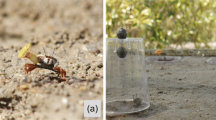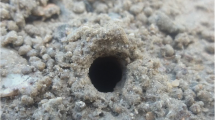Abstract
ᅟMales of fiddler crabs (genus: Uca) construct courtship structures using mud or sand to attract mate-searching females for underground mating. A sensory trap hypothesis proposes that the courtship structures have evolved by trapping the sensory bias for any objects which the crab approach to evade predators. We tested if the sensory bias commonly exists in three species of fiddler crabs and the outgroup Ocypode stimpsoni, by placing crabs individually at the center of an arena, from which they could choose between burrows with and without structures. Contrary to previous results in other species, male U. lactea showed no orientation response toward holes with or without semidomes. Female U. lactea predominantly visited holes with semidomes during reproductive periods but did not show the response during non-reproductive periods. In contrast, female U. arcuata and male U. terpsichores and even the outgroup female O. stimpsoni showed a strong orientation response to an artificial structure. By inferring the evolutionary history of sensory biases and courtship structures, we conclude that the preference for the courtship structures evolved before the genus Uca branched out from the common ancestor of genus Uca and Ocypode and yet that the sensory bias has been modified or lost in U. lactea.
Significance statement
We tested the sensory trap hypothesis for preference for courtship structures in three species of fiddler crabs in different locations and the outgroup O. stimpsoni. Contrary to previous results in other species, one species which build courtship structures (U. lactea) showed sex- and context-dependent orientation responses in the non-courtship context. On the other hand, the other species tested had a strong orientation response to structures. This is the first comparative study supporting that the preference for the courtship structures in fiddler crabs could have different evolutionary paths.

Similar content being viewed by others
References
Andersson M (1994) Sexual selection. Princeton University Press, Princeton
Aoki M, Naruse T, Cheng JH, Suzuki Y, Imai H (2008) Low genetic variability in an endangered population of fiddler crab Uca arcuata on Okinawajima Island: analysis of mitochondrial DNA. Fish Sci 74:330–340
Aoki M, Watanabe Y, Imai H, Kamada M, Wada K (2010) Interpopulation variations in life history traits in the fiddler crab Uca arcuata. J Crustacean Biol 30:607–614
Basolo AL (1990) Female preference predates the evolution of the sword in swordtail fish. Science 250:808–810
Basolo AL (1995) Phylogenetic evidence for the role of a preexisting bias in sexual selection. P Roy Soc B-Biol Sci 259:307–311
Basolo AL (2002) Congruence between the sexes in preexisting receiver responses. Behav Ecol 13:832–837
Choe JC, Crespi BJ (1997) The evolution of mating systems in insects and arachnids. Cambridge University Press, Cambridge
Christy JH (1995) Mimicry, mate choice, and the sensory trap hypothesis. Am Nat 146:171–181
Christy JH, Backwell PRY, Goshima S, Kreuter T (2002) Sexual selection for structure building by courting male fiddler crabs: an experimental study of behavioral mechanisms. Behav Ecol 13:366–374
Christy JH, Backwell PRY, Schober U (2003a) Interspecific attractiveness of structures built by courting male fiddler crabs: experimental evidence of a sensory trap. Behav Ecol Sociobiol 53:84–91
Christy JH, Baum JK, Backwell PRY (2003b) Attractiveness of sand hoods built by courting male fiddler crabs, Uca musica: test of a sensory trap hypothesis. Anim Behav 66:89–94
Dawkins MS, Guilford T (1996) Sensory bias and the adaptiveness of female choice. Am Nat 148:937–942
Endler JA, Basolo AL (1998) Sensory ecology, receiver biases and sexual selection. Trends Ecol Evol 13:415–420
Hennig W (1966) Phylogenetic systematics. University of Illinois Press, Urbana
Holland B, Rice WR (1998) Chase-away sexual selection: antagonistic seduction versus resistance. Evolution 52:1–7
Kim TW, Christy JH (2015) A mechanism for visual orientation may facilitate courtship in a fiddler crab. Anim Behav 101:61–66
Kim TW, Christy JH, Choe JC (2004a) Semidome building as sexual signaling in the fiddler crab Uca lactea (Brachyura:Ocypodidae). J Crustacean Biol 24:673–679
Kim TW, Kim KW, Srygley RB, Choe JC (2004b) Semilunar courtship rhythm of the fiddler crab Uca lactea in a habitat with great tidal variation. J Ethol 22:63–68
Kim TW, Christy JH, Choe JC (2007) A preference for a sexual signal keeps females safe. PLoS One 2:e422
Kim TW, Christy JH, Dennenmoser S, Choe JC (2009) The strength of a female mate preference increases with predation risk. P Roy Soc B-Biol Sci 276:775–780
Kim TW, Christy J, Rissanen RJ, Ribeiro PD, Choe JC (2010a) Effect of food addition on the reproductive intensity and timing of both sexes in a intertidal crab. Mar Ecol Prog Ser 401:183–194
Kim TW, Kim TK, Choe JC (2010b) Compensation for homing errors by using courtship structures as visual landmarks. Behav Ecol 21:836–842
Koga T, Backwell PRY, Christy JH, Murai M, Kasuya E (2001) Male-biased predation of a fiddler crab. Anim Behav 62:201–207
Kuroda M, Wada K, Kamada M (2005) Factors influencing coexistence of two brachyuran crabs, Helice tridens and Parasesarma plicatum, in an estuarine salt marsh, Japan. J Crustacean Biol 25:146–153
Macías Garcia C, Lemus YS (2012) Foraging costs drive female resistance to a sensory trap. P Roy Soc B-Biol Sci 279:2262–2268
Macías Garcia C, Ramirez E (2005) Evidence that sensory traps can evolve into honest signals. Nature 434:501–505
Madden JR, Tanner K (2003) Preferences for coloured bower decorations can be explained in a nonsexual context. Anim Behav 65:1077–1083
Metz M, Klump GM, Friedl TWP (2009) Male nest-building behaviour and mating success in the red bishop (Euplectes orix). Behaviour 146:771–794
Ostlund-Nilsson S (2000) Are nest characters of importance when choosing a male in the fifteen-spined stickleback (Spinachia spinachia)? Behav Ecol Sociobiol 48:229–235
Rodd FH, Hughes KA, Grether GF, Baril CT (2002) A possible non-sexual origin of mate preference: are male guppies mimicking fruit? P Roy Soc B-Biol Sci 269:475–481
Rodríguez RL, Snedden WA (2004) On the functional design of mate preferences and receiver biases. Anim Behav 68:427–432
Rosenberg MS (2001) The systematics and taxonomy of fiddler crabs: a phylogeny of the genus Uca. J Crustacean Biol 21:839–869
Ryan MJ (1998) Sexual selection, receiver biases, and the evolution of sex differences. Science 281:1999–2003
Ryan MJ, Rand AS (1995) Female responses to ancestral advertisement calls in tungara frogs. Science 269:390–392
Shih HT, Mok HK, Chang HW (2005) Chimney building by male Uca formosensis Rathbun, 1921 (Crustacea:Decapoda:Ocypodidae) after pairing: a new hypothesis for chimney function. Zool Stud 44:242–251
Slatyer RA, Fok ESY, Hocking R, Backwell PRY (2008) Why do fiddler crabs build chimneys? Biol Lett 4:616–618
Smith C, Barber I, Wootton RJ, Chittka L (2004) A receiver bias in the origin of three-spined stickleback mate choice. P Roy Soc B-Biol Sci 271:949–955
Stålhandske P (2002) Nuptial gifts of male spiders function as sensory traps. P Roy Soc B-Biol Sci 269:905–908
Sturmbauer C, Levinton JS, Christy J (1996) Molecular phylogeny analysis of fiddler crabs: test of the hypothesis of increasing behavioral complexity in evolution. Proc Natl Acad Sci U S A 93:10855–10857
Wada K, Murata I (2000) Chimney building in the fiddler crab Uca arcuata. J Crustacean Biol 20:505–509
Wada K, Watanabe Y, Kamada M (2011) Function of vertical claw-waving in the fiddler crab Uca arcuata. J Crustacean Biol 31:413–415
Witte K, Klink KB (2005) No pre-existing bias in sailfin molly females, Poecilia latipinna, for a sword in males. Behaviour 142:283–303
Zeil J, Layne JE (2002) Path integration in fiddler crabs and its relation to habitat and social life. In: Wiese K (ed) Crustacean experimental systems in neurobiology. Springer, Berlin, pp. 227–246
Zhu Z, Kim TW, Choe JC (2012) Is female preference for large sexual ornaments due to a bias to escape predation risk? BMC Evol Biol 12
Zucker N (1981) The role of hood-building in defining territories and limiting combat in fiddler crabs. Anim Behav 29:387–395
Zucker N (1983) Courtship variation in the neo-tropical fiddler crab Uca Deichmanni: another example of female incitation to male competition? Mar Behav Physiol 10:57–79
Acknowledgements
We thank Sun-Kee Hong for providing the facilities at the field site in Korea; Hsi-Te Shih, Alung Hung, and Taekeun Kim for helping us study the U. lactea in Taiwan; and Daemin Kim for the field assistance. We also thank John H. Christy, Constantino Macías Garcia, Alison Haupt, Yikweon Jang, Joonghwan Jeon, George Lozano, Tara Smithee, Myron Shekelle, and Keiji Wada for their helpful discussion and comments for this study. This study was financially supported by a special research fund from Amore-Pacific Research and Cultural Foundation (The evolution of beauty: mate choice in fiddler crabs), Ewha Global Top5 Grant 2013 of Ewha Womans University, and Korea Institute of Ocean Science and Technology (PE9944F).
Author information
Authors and Affiliations
Corresponding author
Additional information
Communicated by T. Breithaupt
Rights and permissions
About this article
Cite this article
Kim, T.W., Lee, J.H. & Choe, J.C. Not all crabs are created equal: diverse evolutionary paths of female preferences for courtship structures in fiddler crabs (genus Uca). Behav Ecol Sociobiol 71, 33 (2017). https://doi.org/10.1007/s00265-016-2235-7
Received:
Revised:
Accepted:
Published:
DOI: https://doi.org/10.1007/s00265-016-2235-7




